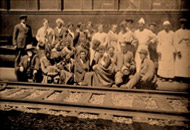At the height of the Spanish American War, in the early summer of 1898, a fear of a smallpox epidemic swept across South Carolina sending panic throughout the state. Tom Spencer of Hickory Grove was well versed on the dreaded disease as he had suffered its debilitating effects during the Civil War. At the time, Spencer had been taken as a prisoner of war and transported to a federal prison at Fort Delaware where smallpox had already gained epidemic proportions. Spencer soon contracted the disease. The Hickory Grove native told his listeners that for about 24 hours he suffered the agonies of the disease as well as the primitive health care. According to him he suffered especially from thirst as he was denied any water since it was believed that water would cause the patient to break out in blisters, which would develop into sores that would cause poxing or pitting of the skin. The attending physician however did allow his patients to hold a bit of ice in their mouth to quench the thirst. He prescribed a light diet and muffled their hands to prevent them from scratching and spreading the disease. After nine days of fever and itching, the army physician considered Spencer to be a convalescent and on the sixteenth day was pronounced as cured. After his recovery he was sent to the hospital to assist with other smallpox patients, which numbered about 200. Spencer, seeing that he had little pitting except on one arm, believed the denial of water was the proper treatment. He followed the same recommendation of those under his care and he later claimed that out of the 200 sufferers he assisted, only ten of the patients died.
In June 1898, Chester County was placed under some small stipulations of quarantine but when Yorkville quarantined itself against travelers from Chester, the townspeople were not impressed. One citizen of Chester thought the Yorkville Board of Health had acted very foolishly, “We haven’t a case of smallpox here . . . and what in the name of sense is Yorkville Quarantining against?” The writer then made some remark about Chester outdoing York in the race of progress. The editor of the Yorkville Enquirer replied: “Now, now neighbor, come. Don’t be illiberal. You folks have had a little quarantine, and what is the matter with our having one too? You discovered you could not manage yours and had to give it up; but because you can’t bottle the wind in a fish net, is no reason why we are not equal to such a task. And so far as your progress is concerned, you make us tired.” To insure that the official in Chester understood that the Yorkville Board of Health had acted with precaution-unlike its sister to the south–they were duly warned: “Anyone that happens to stray up this way without a health certificate will be detained a day or two until its genuiness is established and then cheerfully appropriated. We have noted what you say of vaccination with much interest, and we recognize that vaccination is a preventative against smallpox; but we also note that most your smallpox has, to the disgust of the public, turned out to be chickenpox. Against which no vaccination is not supposed to be a preventative, and with many people in this section it is a question as to whether they would not rather have this milder disease than risk the inconvenience and suffering, to say nothing of the serious danger of vaccination.” While the Yorkville writer agreed that some in York County were being vaccinated on “general principles;” there was no wide fear prevailing in the county. “However,” he said, “we recognize our right to get as scared as a rabbit if we want to, and there is no telling what we might do before we are done with this thing.”
The truth was that many in the county were already scared as a rabbit. John King, a man who had been quarantined in Clover under the care of Doctor J. W. Campbell, had slipped out of town and showed up in Bullock’s Creek. Mr. Banks Good, who ran a store in the community, reported the man’s presence to the editor of the Yorkville Enquirer giving the details of the infected man’s arrival. Shortly afterwards, Doctor Campbell got the word of his patient’s sojourn and informed the newspaper that the man might be a hazard to others and had wanted to keep the man under observation for several more days before releasing him. John Ross of Sharon notified the Clover physician that his patient had been apprehended and was being held at the farm of John Sherer, about a quarter of a mile from the Bullock’s Creek Church. In an attempt to find out whom he might have infected on his travels from Clover, King was questioned as to the route he took. Did he pass through Yorkville or had he come though the countryside? . Campbell however said that the man could not be believed as he was “an unmitigated liar and no dependence can be placed in what he says.” Unwilling to allow the man to return to Clover and possibly infesting others along the way the doctor suggested that he be held at the Sherer farm for a number of days until it was certain he was no longer a threat to others. During his quarantine at Bullock’s Creek reports of an outbreak came from Kings Mountain-from a house where King had stayed on his escape from Clover. The Bethesda Community was next, when Doctor W. M. Love reported that Lee Ashe, a tenant farmer living on R. L. Strait’s farm, was under his care. County Board Commissioner Brice telegraphed the state board of health who instructed him to have all physicians “Treat cases as smallpox, appoint local boards of heath, put patients under guard and have the people of the communities vaccinated.” In those townships which had reported cases, Brice appointed the following as health commissioners:” King’s Mountain: Dr. E. W. Pressley, Dr. J. W. Campbell and Mr. R. A. Clinton. Bethesda: Dr. W. M. Love, A. W. Gladden and J. F. Ashe. Bullock’s Creek: Dr. W. D. Hope, Kelly Inman and J. Starr Moore. All three cases were placed under guard while people living in the three townships of Bethesda, Bullock’s Creek and King’s Mountain underwent vaccination. A. C. McKnight, another Confederate soldier who had smallpox during the Civil War, was appointed to guard the Bethesda patient. After several days, McKnight reported that he could state with assurance that he definitely had smallpox. In the meantime, however, Doctors Pressley and Campbell went out to Bullocks Creek to have a look at John King. Pressley reported to Commissioner Brice that he could not say positively, but he believed the man had chickenpox and not smallpox. By August the Spanish-American War ended with an American victory and the fear of an epidemic was assigned to memory. Relative to the Spanish-American War, the Elders and Cemetery Committee of Bullock Creek Presbyterian Church authorized the creation and raising of a marker commemorating those buried in the cemetery that had been called into duty during that conflict. The obelisk was erected on the cemetery drive in December. This is the fifth commemorative marker in the series that will include the nation’s wars. The first, to honor Revolutionary War veterans buried in the cemetery was provided by the Broad River Basin Historical Society, the others which commemorates veterans of the War of 1812, the Mexican War, the Civil War and the Spanish-American War were commissioned by the Bullock Creek Cemetery Committee. A World War I monument is in the planning stages for later this year. This noble project of the Cemetery Committee is making this historic cemetery, not only one of the most outstanding in York County, but in the Carolina Piedmont.
J.L. West – Author
This article and many others found on the pages of Roots and Recall, were written by author J.L. West, for the YC Magazine and have been reprinted on R&R, with full permission – not for distribution or reprint!
Please enjoy this structure and all those listed in Roots and Recall. But remember each is private property. So view them from a distance or from a public area such as the sidewalk or public road.
Do you have information to share and preserve? Family, school, church, or other older photos and stories are welcome. Send them digitally through the “Share Your Story” link, so they too might be posted on Roots and Recall.
Thanks!
User comments always welcome - please post at the bottom of this page.




Share Your Comments & Feedback: